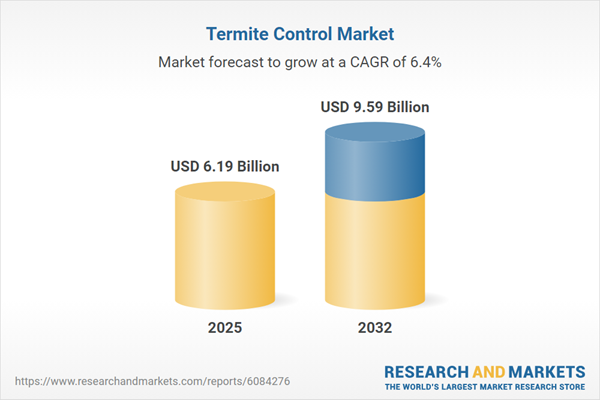Speak directly to the analyst to clarify any post sales queries you may have.
The termite control market continues to transform as sustainability, compliance, and digital innovation reshape operational approaches and strategic priorities for stakeholders worldwide. Executive leaders in manufacturing, service, and distribution confront shifting regulatory demands, the digitalization of service delivery, and supply chain complexities, making informed decision-making essential for long-term growth.
Market Snapshot: Termite Control Market Size and Growth Trajectory
The Termite Control Market grew from USD 5.84 billion in 2024 to USD 6.19 billion in 2025. It is expected to continue growing at a CAGR of 6.38%, reaching USD 9.59 billion by 2032. This expansion is propelled by advancements in pest management, rigorous environmental standards, and evolving end-user requirements across key global regions.
Scope & Segmentation: Comprehensive Coverage of Ecosystem Dynamics
- Termite Species: Conehead, Dampwood, Drywood, Formosan, and Subterranean termites influence treatment protocols, product formulations, and field strategies.
- Product Type: Chemical solutions (liquid insecticides, non-repellents, repellents, termite bait systems including above-ground and in-ground baits) and non-chemical options (biological controls such as microbial treatments and nematodes, and physical barriers including trap systems).
- Control Type: Service offerings (damage repair, inspection, monitoring & maintenance, treatment) and software & analytics (digital inspection reports, route optimization) support operational delivery and performance tracking.
- Application: Post-construction (including baiting programs, corrective soil treatments, fumigation, localized treatments) and pre-construction (physical barrier installation, reticulation network installation, soil pretreatment, termite-resistant materials) address a spectrum of structural scenarios.
- End User: Educational institutions, government and municipalities, healthcare, homeowners, hospitality, property management, and real estate developers, each with distinct operational and compliance needs.
- Distribution Channel: Direct sales, online platforms, and retail stores reflect evolving go-to-market approaches in global markets.
- Geographic Coverage: Americas (North America and Latin America), Europe, Middle East & Africa, and Asia-Pacific, with deep dives into country-level and regional regulatory, ecological, and channel variations.
Key Takeaways for Decision-Makers
- Scientific advancements and tighter environmental policies are driving demand for integrated pest management solutions with lower toxicity profiles and greater digital integration.
- Vendor viability hinges on transparent compliance frameworks, robust supply chain strategies, and the ability to adapt service delivery to shifting regulatory landscapes and consumer preferences.
- Region-specific termite species, construction methods, and climate conditions require localized strategies, especially in high-growth Asia-Pacific and regulatory-diverse EMEA regions.
- Digital transformation—including remote monitoring, predictive analytics, and customer-facing platforms—is reshaping service models and documentation standards sector-wide.
- Manufacturers and service firms that invest in R&D for alternative treatments, professional certification, and channel partnerships position themselves to gain market share in both established and emerging segments.
- Collaboration across industry, regulatory, and research partners supports the development and adoption of more effective, sustainable interventions.
Tariff Impact
- Recent U.S. tariffs on chemical precursors and equipment have prompted a shift toward domestic sourcing, supplier diversification, and scenario-based supply chain planning.
- Some market participants have responded by expanding local manufacturing and nearshoring, while reengineering procurement and reformulation strategies to offset input cost volatility.
- Trade policy dynamics reinforce the importance of resilience and proactive risk management across procurement and distribution.
Methodology & Data Sources
This research leverages primary interviews with leaders in pest control, procurement, regulatory, and technical fields, triangulated with secondary analysis of filings, patents, and market disclosures. Rigorous cross-validation ensures the segmentation framework reflects operational realities and regional contexts.
Why This Report Matters
- Actionable guidance equips executives with the insights needed to navigate evolving regulatory and sustainability demands in termite control solutions.
- Benchmark actionable product development, procurement, and service delivery strategies against current best practices globally.
- Inform investment decisions and partnership strategies with a comprehensive view of market-relevant trends and emerging risks.
Conclusion
Adaptation to scientific, regulatory, and digital change is now central in the termite control market. Leaders who build resilience, embrace innovation, and elevate service delivery will be best positioned for sustained advantage.
Table of Contents
3. Executive Summary
4. Market Overview
7. Cumulative Impact of Artificial Intelligence 2025
Companies Mentioned
The companies profiled in this Termite Control market report include:- BASF SE
- Anticimex International AB
- Control Solutions Inc.
- Arrow Exterminators, Inc.
- Bulwark Exterminating, LLC
- Corteva Agriscience
- Ensystex, Inc.
- Extermco Pest Control
- Cook's Pest Control
- Flash Exterminating
- FMC Corporation
- Greenhow Inc.
- Guaranty Pest Control, Inc.
- Ikari Shodoku Co., Ltd.
- Jukaso Pest Control Pvt. Ltd.
- Massey Services, Inc.
- Orion Pest Solutions Pvt. Ltd.
- PQGS SOLUTIONS (OPC) PVT LTD
- Pestgogo
- Rentokil Initial PLC
- Rollins, Inc.
- Rose Pest Solutions
- Scherzinger Pest Control
- Slug-A-Bug
- Sumitomo Chemical Co., Ltd.
- Syngenta Crop Protection, LLC
- Truly Nolen of America, Inc.
- UPL Ltd.
- Aptive Environmental, LLC
- Moxie Pest Control, LP
- Certus Pest, Inc.
- Termatrac Pty Ltd
Table Information
| Report Attribute | Details |
|---|---|
| No. of Pages | 184 |
| Published | November 2025 |
| Forecast Period | 2025 - 2032 |
| Estimated Market Value ( USD | $ 6.19 Billion |
| Forecasted Market Value ( USD | $ 9.59 Billion |
| Compound Annual Growth Rate | 6.3% |
| Regions Covered | Global |
| No. of Companies Mentioned | 33 |









